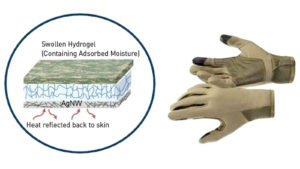
Soldiers stationed in the arctic know that it’s a challenge to stay warm while executing their duties in the frigid weather. Protective clothing is often bulky and makes it difficult to maneuver, and wearers often become overheated and sweaty. A group of scientists at the U.S. Army Natick Soldier Research, Development & Engineering Center is studying high-tech fabrics that heat up and capture sweat when powered.
The work was inspired by research at Stanford University that synthesized very fine silver nanowires and placed a network of the wires on cotton. The fabric was warmed when power was applied to the nanowires. The army scientists are looking at ways to make this research suitable for military uniforms, such as polyester and cotton/nylon blends. They discovered that applying three volts to one-inch by one-inch test swatches of these fabrics raised the temperature by 100° F in just one minute. Ultimately, soldiers could dial the voltage up or down to vary the amount of heat their uniforms produce to match weather conditions.
To control dampness, researchers also incorporated a layer of sweat-absorbing hydrogel particles made of polyethylene glycol or poly(N-isopropylacrylamide), which are thought to stop other layers in the fabrics from getting wet.
The silver nanowires stand up to laundering, and the researchers are looking at how best to apply the hydrogel so it is equally durable. The team is also looking at how the silver mesh and hydrogel interact with each other. For more information, visit www.acs.org.
 TEXTILES.ORG
TEXTILES.ORG


